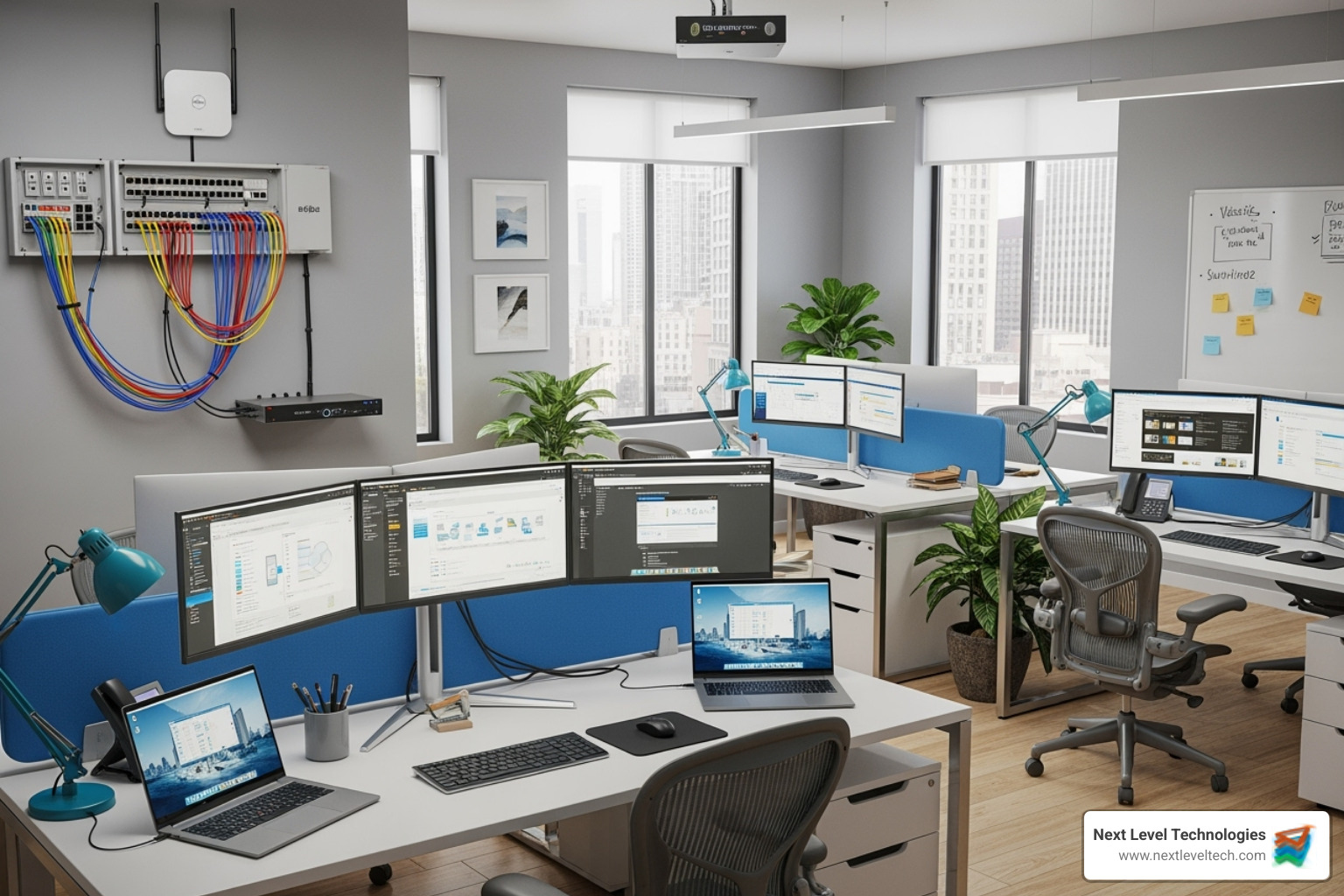The Ultimate Guide to IT Compliance Benchmarks
June 27, 2025

Unlock growth with smart IT solutions for small business. Boost productivity, secure data, and optimize costs with expert guidance.
January 1, 2026

Boost your practice with 7 amazing Healthcare Management IT Services. Secure data, improve efficiency & ensure compliance. Discover your IT partner today!
December 31, 2025

Discover the ins and outs of remote access solutions. Enhance productivity, fortify security, and empower your remote workforce.
December 30, 2025
June 27, 2025
IT Compliance Benchmarks are standardized security configurations and control frameworks that help organizations validate whether their systems meet specific regulatory and industry requirements. These benchmarks serve as measurable reference points to assess your cybersecurity posture against established best practices.
Key IT Compliance Benchmarks include:
The stakes couldn't be higher. Recent data shows that data breaches rose by 40% year-over-year, with the average cost of non-compliance reaching $14 million per incident. Yet only 18% of organizations have successfully integrated their risk and compliance activities.
Most mid-sized businesses struggle with compliance fatigue - juggling multiple frameworks while managing day-to-day operations. The manual approach is failing. Over 30% of respondents spend 30% or more of their time on manual compliance processes, taking valuable resources away from core business functions.
As Steve Payerle, President of Next Level Technologies, I've helped businesses across Columbus, Ohio and Charleston, WV steer IT Compliance Benchmarks for over 15 years through our comprehensive managed IT services. Our extensively trained cybersecurity team specializes in changing complex compliance requirements into streamlined, automated processes.

Related content about IT Compliance Benchmarks:- IT compliance assessments- IT compliance certifications- IT compliance monitoring
IT Compliance Benchmarks are detailed instruction manuals for keeping your computer systems secure and compliant. They're specific, step-by-step technical guides that tell you exactly how to configure your systems to meet regulatory requirements.
Think of it this way: if regulations tell you to "drive safely," benchmarks are the specific speed limits, stop signs, and traffic rules that actually make driving safe.

Risk reduction is the biggest reason to care about benchmarks. Our extensively trained cybersecurity team has seen how following established benchmarks like CIS Benchmarks prevents the most common attacks.
Customer trust has become make-or-break in today's business environment. Financial protection can't be ignored either - GDPR fines can reach €20 million or 4% of worldwide annual revenue, HIPAA violations range from $100 to $1.5 million per incident.
Standards are broad guidelines. Regulations are legal requirements with penalties. Benchmarks translate high-level requirements into specific configurations.
| Type | Scope | Compliance | Implementation | Examples |
|---|---|---|---|---|
| Regulations | Legally mandated | Mandatory | Penalties for non-compliance | GDPR, HIPAA, SOX |
| Standards | Industry guidance | Voluntary (often required by customers) | Certification available | ISO 27001, NIST CSF |
| Benchmarks | Technical specifications | Validation tool | Specific configurations | CIS Benchmarks, DISA STIGs |
CIS Benchmark development starts with subject matter experts analyzing current threats. Drafts go through public review and consensus-building before publication through the CIS Workbench, with monthly updates.
NIST follows similar collaborative approaches with international input. Our extensively trained team participates in these industry discussions, helping clients implement benchmarks effectively while anticipating future changes.
For deeper insights, the 2024 Compliance Benchmark Report provides valuable data from over 700 compliance professionals.
Navigating IT Compliance Benchmarks is like building a house - regulations tell you it needs to be safe, but benchmarks give you the actual blueprints and construction guide.

The landscape includes security configuration benchmarks like CIS Benchmarks, risk management frameworks such as NIST CSF and ISO 27001, industry-specific standards like PCI DSS and HIPAA, and government standards like FedRAMP and CMMC.
CIS Benchmarks deliver the biggest bang for your buck with their two-tier approach. Level 1 benchmarks cover essential security settings every organization should implement without breaking systems. Level 2 benchmarks provide more restrictive settings for high-security environments.
Our extensively trained cybersecurity team typically recommends Level 1 across all systems, then selectively applying Level 2 to critical infrastructure.
CIS Benchmarks connect directly to regulatory requirements - access management controls address HIPAA's Security Rule, network security configurations help satisfy PCI DSS requirements, and system hardening controls address GDPR's Article 32.
You can download the benchmarks directly, though successful implementation requires careful planning most internal IT teams struggle to manage.
NIST Cybersecurity Framework 2.0 added "Govern" as a sixth core function to the original five (Identify, Protect, Detect, Respond, Recover). The tiered maturity approach helps growing businesses progress from Partial to Risk-Informed to Repeatable and eventually Adaptive capabilities.
NIST SP 800-53 provides over 1,000 security and privacy controls organized into families like Access Control and Incident Response. NIST CSF 2.0's improved focus on supply chain risk management addresses the reality that most breaches now involve third-party vulnerabilities.
ISO/IEC 27001 provides internationally recognized cybersecurity standards with formal certification. The risk-based approach focuses on your specific threats rather than one-size-fits-all checklists.
The Information Security Management System (ISMS) requirement builds sustainable programs with formal policies and continuous improvement. Annex A provides 93 security controls covering access control, cryptography, and incident management.
Related standards like ISO 27017 (cloud security) and ISO 27701 (privacy management) extend this foundation into specialized areas.
Implementing benchmarks strategically addresses multiple regulatory requirements simultaneously:
GDPR compliance: CIS Benchmarks help with Article 32 technical measures, NIST CSF provides risk assessment methodology for Article 35, ISO 27001 delivers comprehensive measures Article 32 demands.
HIPAA Security Rule: CIS Benchmarks address access control and audit controls, NIST SP 800-53 provides detailed safeguard guidance, ISO 27001 offers management system approaches.
PCI DSS requirements: CIS network security configurations help satisfy Requirements 1 and 2, monitoring controls address Requirement 10.
Understanding penalty landscapes makes this mapping critical - GDPR fines reach €20 million, HIPAA violations cost up to $1.5 million, PCI DSS non-compliance results in substantial fines and loss of payment processing privileges.
Implementing IT Compliance Benchmarks doesn't have to feel overwhelming. After helping hundreds of businesses across Columbus and Charleston, our cybersecurity team has learned success comes from methodical approaches that respect both security needs and daily operations.

Start with gap assessment to understand current security posture. Asset inventory identifies what needs protection. Configuration management sets secure baselines. Change control prevents accidental security degradation. Continuous monitoring provides early warning systems. Staff training ensures consistent policy adherence.
Industry matters - healthcare organizations have different priorities than retailers. Geography plays bigger roles with GDPR for European customers, CCPA for California businesses. Customer demands often require SOC 2 reports or specific security frameworks. Risk appetite varies between high-risk industries and those with more operational flexibility.
For organizations starting their compliance journey, our guide on IT Compliance Assessments walks through practical evaluation approaches.
| Aspect | Level 1 (Basic) | Level 2 (Hardened) |
|---|---|---|
| Security Impact | Essential protections against common threats | Improved protection against advanced threats |
| Operational Impact | Minimal impact on system functionality | May reduce functionality or require workarounds |
| Implementation Effort | Straightforward, can often be automated | Requires careful planning and testing |
| Suitable For | General business environments | High-security environments, sensitive data |
Our extensively trained team typically recommends Level 1 across all systems, then selectively implementing Level 2 for critical infrastructure.
Configuration management tools have become game-changers. CIS Hardened Images provide pre-configured templates. Microsoft Purview Compliance Manager helps Microsoft environments. Modern GRC platforms provide centralized dashboards for multiple frameworks simultaneously.
Recent research shows 44% of companies now use AI to optimize compliance processes, with 83% supporting AI use in audit processes. Organizations using automated tools report significant time savings and improved accuracy.
Our guide on IT Compliance Monitoring provides practical tool selection advice.
Legacy systems require creative solutions like network segmentation and compensating controls. Siloed teams create gaps attackers exploit - organizations managing risk and compliance separately are significantly more likely to experience breaches. Manual evidence collection consumes enormous time - over 30% of organizations spend 30% of time on manual processes.
Budget limitations are real, but non-compliance averages $14 million per incident. Remote workforce challenges require zero-trust architectures. Third-party risk has exploded - 61% of organizations reported third-party breaches last year.
The IBM Cost of Data Breach Report demonstrates that mature security programs experience significantly lower breach costs and faster response times.
The world of IT Compliance Benchmarks is evolving rapidly. The biggest shift is from "set it and forget it" compliance to continuous monitoring. Our extensively trained cybersecurity team helps businesses prepare for this transition with impressive results.

Continuous controls monitoring is becoming standard - 91% of companies plan implementation within five years. The talent shortage (4 million professionals in 2024, potentially 85 million by 2030) makes automation essential.
Supply chain security moved from nice-to-have to must-have. Software Bill of Materials (SBOM) requirements are becoming mandatory. Zero trust architecture replaces traditional perimeter-based security. Cloud-native benchmarks address environments traditional frameworks don't cover.
AI revolutionizes compliance efficiency - automated evidence collection reduces manual effort by 70%. Real-time analytics spot violations as they happen, not months later during audits.
But generative AI creates new risks requiring entirely new approaches. GenAI drove 1,265% surge in phishing attacks. Organizations need new controls for algorithmic accountability and AI decision-making transparency.
The cost curve for compliance automation continues improving dramatically, making enterprise-grade compliance monitoring accessible to small and medium businesses.
Traditional IT Compliance Benchmarks were designed for on-premises servers. Kubernetes security requires specialized benchmarks for container orchestration. SaaS security posture management becomes essential as organizations adopt hundreds of cloud applications.
Multi-cloud foundations provide consistent security baselines across AWS, Azure, and Google Cloud. Edge computing and IoT security present new challenges for thousands of connected devices. Serverless computing and microservices architectures require rethinking traditional security models.
Our team's extensive training in cloud security helps businesses steer these requirements without overwhelming complexity. Our guide on IT Security Policy Compliance provides practical advice on adapting policies to cloud-native architectures.
Ignoring IT Compliance Benchmarks is potentially devastating. The average cost of non-compliance hits $14 million per incident including fines, legal fees, lost revenue, and remediation costs.
GDPR violations cost up to €20 million or 4% of worldwide annual revenue. HIPAA violations range from $100 to $1.5 million per incident. PCI DSS non-compliance can eliminate your ability to process credit cards.
Beyond financial impact, organizations ignoring benchmarks experience more frequent security incidents, increased downtime, higher IT costs, and reduced system performance. Legal consequences include investigations, customer liability, and business operation restrictions. Reputational damage affects customer retention, employee recruitment, and company valuation.
Our extensively trained cybersecurity team helps businesses avoid these pitfalls by implementing proper compliance frameworks from the start.
CIS Benchmarks get monthly updates based on community feedback and emerging threats. NIST Frameworks see major updates every 3-5 years plus regular minor updates. ISO Standards undergo review every 5 years with amendments anytime. Regulatory requirements can change with little warning.
Stay current by subscribing to update notifications, joining professional communities, and establishing quarterly review cycles. Automated monitoring tools check for updates and assess compliance status continuously.
At Next Level Technologies, our cybersecurity team continuously monitors benchmark updates and regulatory changes, proactively notifying clients about relevant updates and helping implement necessary changes.
Small businesses can't afford not to have compliance. Success comes from smart, phased approaches rather than trying to do everything at once.
Start with foundation (months 1-3): Basic risk assessment, CIS Benchmark Level 1 on critical systems, basic policies, automatic security updates.
Build core controls (months 4-6): Expand CIS implementation, multi-factor authentication, backup procedures, vulnerability scanning.
Add advanced controls (months 7-12): Continuous monitoring, incident response procedures, third-party risk management, formal certifications if required.
Leverage free resources like CIS Benchmarks and NIST frameworks. Prioritize high-impact controls addressing multiple requirements. Use managed services when outsourcing makes financial sense. Automation reduces ongoing costs while improving consistency.
Most mid-sized organizations allocate $100,000-$1 million annually to compliance, but this can be phased over time. Our extensively trained team works with SMBs to create realistic implementation timelines fitting their budgets while providing meaningful protection.
The journey through IT Compliance Benchmarks reveals a fundamental truth: compliance isn't just about avoiding penalties—it's about building a business customers can trust and that can thrive in an increasingly digital world.
Organizations with mature compliance programs see 67% fewer security incidents, complete audits 45% faster, reduce compliance costs by 52%, and enjoy 78% improvement in customer trust scores.

After 15 years helping businesses in Columbus and Charleston steer these waters, successful compliance isn't about implementing every possible control—it's about understanding your unique risks, choosing the right frameworks, and building systems that grow with your business.
Our extensively trained cybersecurity team has seen how the right approach to IT Compliance Benchmarks transforms businesses. We've helped healthcare practices streamline HIPAA compliance, guided growing companies through first SOC 2 audits, and helped manufacturers implement frameworks protecting both regulatory compliance and intellectual property.
The future is bright for organizations approaching compliance strategically. AI-driven compliance tools make managing complex requirements easier. Continuous monitoring platforms provide real-time visibility. Cloud-native security benchmarks evolve to match how businesses actually operate.
Success combines the right tools with experienced guidance and clear compliance objectives. Whether starting your compliance journey or modernizing existing programs, the key is taking that first step with confidence.
Every business deserves to operate with peace of mind knowing their systems are secure, data is protected, and compliance requirements are met. That's our commitment to the business community in Columbus, Charleston, and beyond.
Ready to transform your approach to IT Compliance Benchmarks? Our team is here to help you build a compliance program that protects your business while enabling growth. When compliance is done right, it becomes less of a burden and more of a competitive advantage.
For deeper insights into comprehensive compliance management, explore our guide on Top Strategies IT Service Providers Use to Guarantee Your Data Privacy and Compliance.
Remember: compliance is a journey, not a destination. With the right partner, it's a journey leading to stronger security, greater customer trust, and sustainable business success.
Unlock growth with smart IT solutions for small business. Boost productivity, secure data, and optimize costs with expert guidance.
January 1, 2026
Boost your practice with 7 amazing Healthcare Management IT Services. Secure data, improve efficiency & ensure compliance. Discover your IT partner today!
December 31, 2025
Next Level Technologies was founded to provide a better alternative to traditional computer repair and ‘break/fix’ services. Headquartered in Columbus, Ohio since 2009, the company has been helping it’s clients transform their organizations through smart, efficient, and surprisingly cost-effective IT solutions.
